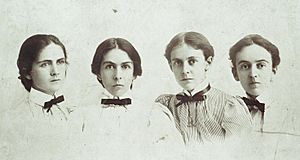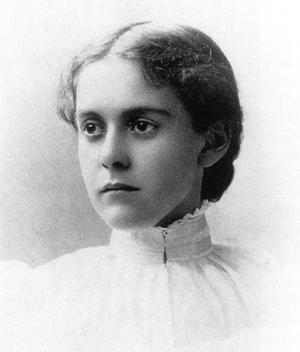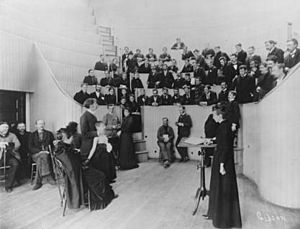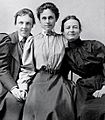Alice Hamilton facts for kids
Quick facts for kids
Dr. Alice Hamilton
|
|
|---|---|
 |
|
| Born | February 27, 1869 Manhattan, New York City, U.S.
|
| Died | September 22, 1970 (aged 101) |
| Nationality | American |
| Alma mater | Miss Porter's School (1888) University of Michigan (1893) University of Leipzig, University of Munich, and University of Frankfurt (1895) Johns Hopkins University (1897) University of Chicago (1899–1901) |
| Awards | Albert Lasker Public Service Award (1947) |
| Scientific career | |
| Fields | Occupational health, industrial toxicology |
| Institutions | Hull House Woman's Medical School of Northwestern University Memorial Institute for Infectious Diseases Harvard Medical School |
| Doctoral advisor | Cara Lener |
| Other academic advisors | Simon Flexner |
Alice Hamilton (born February 27, 1869 – died September 22, 1970) was an American doctor, scientist, and writer. She was a top expert in occupational health. This field studies how jobs affect people's health. She also helped start the study of industrial toxicology. This looks at how chemicals in factories can harm workers.
Alice Hamilton studied at the University of Michigan Medical School. She lived and worked at Hull House in Chicago from 1887 to 1919. There, she met many working-class families. She saw the dangers they faced in their jobs every day. In 1897, she became a professor at the Woman's Medical School of Northwestern University. Later, in 1919, she made history. She was the first woman ever to be a professor at Harvard University.
Her science work focused on illnesses people got from their jobs. She studied the harmful effects of metals and chemical compounds used in factories. Besides her science, Hamilton was also a social reformer. She worked to help people and was a peace activist. She won many awards, like the Albert Lasker Public Service Award. Her important work helped make workplaces safer. Some even say her efforts led to the creation of the Occupational Safety and Health Administration (OSHA) in the United States.
Contents
Alice Hamilton's Early Life
Alice Hamilton was born on February 27, 1869, in Manhattan, New York City. She was the second of five children. Her parents were Montgomery and Gertrude Hamilton. She grew up in Fort Wayne, Indiana, with her large family. Her grandfather, Allen Hamilton, was a successful businessman there.
Alice's father, Montgomery, went to Princeton University and Harvard Law School. He met Alice's mother, Gertrude, in Germany. Alice's family lost some money when her father's business failed. But her mother, Gertrude, stayed active in their community.
Alice had three sisters and one brother. All of them became very successful. Her sisters were Edith, Margaret, and Norah. Her brother was Arthur. The sisters were very close throughout their lives. Edith (1867–1963) became a famous writer. She wrote about ancient Greek and Roman civilizations. Margaret (1871–1969) also became an educator. Norah (1873–1945) was an artist. Arthur (1886–1967) was a writer and professor. He was the only one of the siblings to marry.
Alice Hamilton's Education
Alice and her siblings were taught at home when they were young. Alice then went to Miss Porter's School in Farmington, Connecticut. She studied there from 1886 to 1888. Many women in her family had gone to this school before her.
Alice wanted to help people in the world. She chose medicine as a way to support herself. She loved to read and was inspired by books to become a doctor. Even though she hadn't studied much science yet, she was determined.
After Miss Porter's School, Alice studied science in Fort Wayne. She also studied anatomy for a year. In 1892, she enrolled at the University of Michigan Medical School. She learned from many great professors there. Alice earned her medical degree in 1893.
After medical school, Alice worked as an intern in hospitals. She gained experience helping patients. But she decided she didn't want to open her own medical practice. In 1895, she returned to the University of Michigan. She studied bacteriology and became interested in public health.
In 1895, Alice and her older sister, Edith, went to Germany. Alice wanted to study bacteriology and pathology. Edith wanted to study classic literature. They faced some challenges because they were women. Some universities in Germany were not welcoming to female students.
When Alice came back to the United States in 1896, she continued her studies. She went to Johns Hopkins University Medical School for a year. There, she worked with famous doctors and learned a lot.
Alice Hamilton's Career
Working at Chicago's Hull House
In 1897, Alice Hamilton became a professor of pathology. This was at the Woman's Medical School of Northwestern University. Soon after moving to Chicago, she joined Hull House. This was a settlement house started by social reformers Jane Addams and Ellen Gates Starr. Alice taught and did research at the medical school during the day. But she lived at Hull House from 1897 to 1919.
Alice became Jane Addams's personal doctor. She also volunteered at Hull House. She taught English and art. She ran clubs and a clinic for babies. She also visited sick people in their homes. Other people living at Hull House included Alice's sister Norah.
Even after Alice left Chicago in 1919 for Harvard, she returned to Hull House. She stayed there for several months each spring. She continued this until Jane Addams passed away in 1935.
Living and working at Hull House, Alice saw how dangerous jobs affected workers. She saw people suffering from carbon monoxide and lead poisoning. This made her very interested in workers' problems. She wanted to combine her medical knowledge with social reform. Her goal was to improve the health of American workers.
When the Woman's Medical School closed in 1902, Alice worked at a research institute. She investigated a typhoid outbreak in Chicago. Her work helped replace the chief sanitary inspector. Then, she started focusing on diseases caused by industrial work.
The Industrial Revolution in the late 1800s created new workplace dangers. Alice noticed that industrial medicine was not studied much in America. She wanted to change this. In 1908, she published her first article on the topic.
Becoming a Medical Investigator
Alice Hamilton started her important work in public health in 1910. The governor of Illinois appointed her as a medical investigator. She led studies on industrial poisons like lead. She wrote a report called the "Illinois Survey." This report showed how workers were exposed to lead poisoning. Her work helped pass the first workers' compensation laws in Illinois in 1911. These laws made employers protect their workers.
By 1916, Alice Hamilton was the top expert on lead poisoning in America. For the next ten years, she studied many health issues. She looked at how substances like aniline dyes, carbon monoxide, mercury, and benzene affected workers. In 1925, she spoke out against using lead in gasoline. She warned about its dangers to people and the environment. But leaded gasoline was still allowed.
Her study on making white lead and lead oxide was very important. She visited factories, talked to workers, and collected details on poisoning cases. This method was called "shoe leather epidemiology." She combined this with toxicology, the science of poisons. Alice Hamilton helped create the field of occupational epidemiology and industrial hygiene. Her findings were so strong that they led to new laws. These changes greatly improved workers' health.
During World War I, the U.S. Army asked her for help. Workers at a munitions plant were getting sick. Alice found that they were being harmed by the explosive trinitrotoluene (TNT). She suggested workers wear special clothes. These clothes would be washed at the end of each shift. This solved the problem.
Hamilton's famous research included studies on carbon monoxide poisoning in steelworkers. She also studied mercury poisoning in hat makers. She looked into a hand condition affecting workers using jackhammers. She investigated high rates of tuberculosis among stonecutters. Her work helped improve safety in many industries.
Women's Rights and Peace Activist
While at Hull House, Alice Hamilton was active in women's rights and peace movements. In 1915, she traveled with Jane Addams to a women's congress in the Netherlands. They met other activists there. She also visited German-occupied Belgium.
In 1919, Alice returned to Europe with Jane Addams. They attended another women's congress in Switzerland. Alice, Jane Addams, and others also went on a humanitarian mission to Germany. They delivered food aid and checked on famine reports.
Professor at Harvard Medical School
In January 1919, Alice Hamilton accepted a job at Harvard Medical School. She became an assistant professor in a new department. This made her the first woman ever appointed to the Harvard University faculty. Her appointment was celebrated. She famously said, "Yes, I am the first woman on the Harvard faculty—but not the first one who should have been appointed!"
Alice worked at Harvard from 1919 until she retired in 1935. She was never promoted to a higher rank. She had part-time jobs that allowed her to keep doing research. She also spent several months each year at Hull House. Alice faced unfair treatment because she was a woman. She was not allowed to join certain clubs or attend social events. She couldn't even march in the university's graduation ceremonies like the male professors.
Despite this, Alice was successful at raising money for Harvard. She continued to write and research dangerous jobs. She published "landmark reports" for the U.S. Department of Labor. She also wrote Industrial Poisons in the United States (1925). This was the first American textbook on the subject. She wrote another textbook, Industrial Toxicology (1934). In 1925, she strongly criticized adding tetraethyl lead to gasoline.
Alice also remained active in social reform. She cared deeply about civil liberties and peace. She supported laws to protect women workers. Some people called her a "radical" for her views. From 1924 to 1930, she was the only woman on the League of Nations Health Committee. She visited the Soviet Union in 1924 and Nazi Germany in 1933. She wrote an article for The New York Times about how the Nazis used young people.
Later Years
After retiring from Harvard in 1935, Alice Hamilton became a medical consultant. She worked for the U.S. Division of Labor Standards. Her last major study was in 1937–38. She investigated the viscose rayon industry. She also served as president of the National Consumers League from 1944 to 1949.
Alice spent her retirement years in Hadlyme, Connecticut. She lived in a home she bought with her sister Margaret. She continued to write even in retirement. Her autobiography, Exploring the Dangerous Trades, was published in 1943. She also updated her textbook, Industrial Toxicology, in 1949. Alice enjoyed reading, sketching, and spending time with family and friends.
Death
Alice Hamilton passed away from a stroke at her home on September 22, 1970. She was 101 years old. She is buried in Cove Cemetery in Hadlyme.
Legacy
Alice Hamilton was a dedicated researcher. She fought hard against using toxic substances in workplaces. Her death came at a time when the United States was finally ready to enact comprehensive workplace safety laws. Within just three months of her passing in 1970, the U.S. Congress passed the Occupational Safety and Health Act. This landmark legislation created the Occupational Safety and Health Administration (OSHA), a federal agency dedicated to ensuring safe and healthy working conditions for all Americans. Many credit Alice Hamilton's tireless research and advocacy over decades with laying the essential groundwork for this crucial act. She was a true crusader against the use of toxic substances in the workplace, and her work continues to protect millions of people every day.
Recognition and Awards
Alice Hamilton received many honors for her important work:
- She received honorary degrees from the University of Michigan and other colleges.
- In 1935, Eleanor Roosevelt gave her the Chi Omega National Achievement Award.
- In 1947, she was the first woman to receive the Albert Lasker Public Service Award.
- In 1956, TIME magazine named her "Woman of the Year" in medicine.
- In 1973, she was added to the National Women's Hall of Fame.
- In 1987, a research facility was named the Alice Hamilton Laboratory for Occupational Safety and Health.
- In 1995, the U.S. Postal Service honored her with a postage stamp.
- In 2000, statues of Alice and her sister Edith were put up in Fort Wayne, Indiana.
- In 2002, the American Chemical Society recognized her work as a National Historic Chemical Landmark.
- Many awards and lectures are named after her today. These honor her achievements in occupational and environmental health.
Selected Published Works
Books:
- Industrial Poisons in the United States (1925)
- Industrial Toxicology (1934, revised 1949)
- Exploring the Dangerous Trades: The Autobiography of Alice Hamilton, M.D. (1943)
Articles:
- "Hitler Speaks: His Book Reveals the Man," Atlantic Monthly (April 1933)
- "The Youth Who Are Hitler's Strength," New York Times, 1933
- "A Woman of Ninety Looks at Her World," Atlantic Monthly (1961)
Images for kids
-
Theodate Pope, Alice Hamilton, and a student believed to be Agnes Hamilton, 1888. Courtesy of Miss Porter's School.
See also
 In Spanish: Alice Hamilton para niños
In Spanish: Alice Hamilton para niños






